|
|
| Pompeii
Pompeii was an ancient city located in the modern comune of Pompei near Naples. Pompeii, along with Herculaneum and many villas in the surrounding area, was buried under 4 to 6 m (13 to 20 ft) of volcanic ash and pumice in the eruption of Mount Vesuvius in AD 79.
Largely preserved under the ash, the excavated city offered a unique snapshot of Roman life, frozen at the moment it was buried, and an extraordinarily detailed insight into the everyday life of its inhabitants, although much of the evidence was lost in the early excavations. It was a wealthy town, enjoying many fine public buildings and luxurious private houses with lavish decorations, furnishings and works of art which were the main attractions for the early excavators. Organic remains, including wooden objects and human bodies, were entombed in the ash and decayed leaving voids which archaeologists found could be used as moulds to make plaster casts of unique and often gruesome figures in their final moments of life.
|
|
Currently 13 panoramas in this collection
|
|
Pompeii's Forum
The Civil Forum is the core of daily life of the city and is the focal point of all the main public buildings for city administration and justice, business management, and trade activities such as markets, as well as the main places of citizen worship. The square of the Forum originally looked like a simple open area with an overall regular shape, made of clay and its western side opened on to the Sanctuary of Apollo, whereas the eastern side had a row of shops.
2017-03-13
Show on map
|
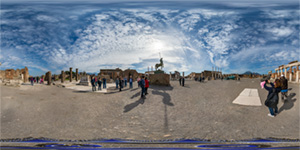
Pompeii's Forum
Fullscreen
|
|
Pompeii's Large Theater 1
The Large Theatre was built by exploiting the natural slope of the hill for the construction of the auditorium. The staircase was separated into three areas with corridors, which were in turn divided into five sectors, and was based on a passage with a barrel vault. It was built around the middle of the 2nd century BC and significantly restored according to the Roman stlye.
2017-03-13
Show on map
|
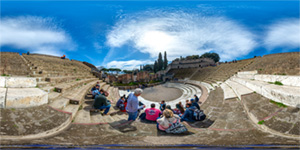
Pompeii's Large Theater 1
Fullscreen
|
|
Pompeii's Large Theater 2
An inscription, visible at the entrance of the corridor that provides access to the east and that is one of the very few representations known with reference to the name of the architectus, recalls the works carried out in the Augustan age by Marcus Artorius Primus.
These works concern the scene and the stage, the adoption of the velarium, a large tarp used as a cover for the warmer days and the numbering of the seats. In the theatre they represented comedies and tragedies of Greek-Roman tradition.
2017-03-13
Show on map
|
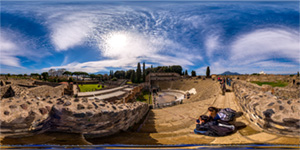
Pompeii's Large Theater 2
Fullscreen
|
|
Pompeii's Small Theater
The Odeon or theatrum tectum as it was called by the Romans, was built during the early years of the colony (79 BC), as evidenced by an inscription. This building was dedicated to the representation of the most popular theatrical genre at the time, miming, and could also be used for musical and singing performances.
It was richly decorated with multi- coloured marbles whereas large male tuff figures (telamones) supported the steps. The structure was completely covered by a functional roof to improve the acoustics. The plaster of the external masonry retains many graffiti of the spectators of the shows that were held here, sometimes even from very distant regions.
2017-03-13
Show on map
|
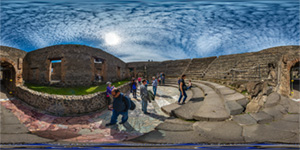
Pompeii's Small Theater
Fullscreen
|
|
Pompeii's House of Menander
The house of Menander is a typical example of a Roman home of a high-ranking family. The atrium has frescoes with scenes from the Iliad and the Odyssey. The peristyle is rhodium-shaped, with the north side higher. The house owes its name to a picture of Menander, an Athenian playwriter, placed in the portico. The house has a small thermal area below which there is a basement, perhaps a cellar, where a box was found with 118 pieces of silverware, now on display at the National Archaeological Museum of Naples.
2017-03-13
Show on map
|

Pompeii's House of Menander
Fullscreen
|
|
Pompeii's Forum (2)
The Forum was significantly modified between the 3rd and 2nd century BC when the shape of the square was regularised, surrounded by porticoes and the bottom paved with slabs of tuff. The axis of the square became the facade of the Temple of Jupiter, aligned with Mount Vesuvius.
At the beginning of the Imperial age the Forum was re-paved with travertine slabs, some of which are no longer in their original location and have a groove to accommodate the bronze letters that belonged to a large inscription.
2017-03-13
Show on map
|
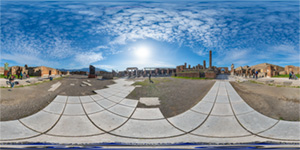
Pompeii's Forum (2)
Fullscreen
|
|
Pompeii's Basilica
Pompeii's Basilica, with its extension of 1,500 square metres, was the most sumptuous building of the Forum, and its space was used to carry out business and for the administration of justice. It is accessed from the Forum through five entrances separated by tuff pillars; inside it is divided into three naves with two rows of brick columns with Ionic capitals. The Basilica is dated back to 130-120 BC and is one of the oldest examples of this type of building in the entire Roman world.
2017-03-13
Show on map
|
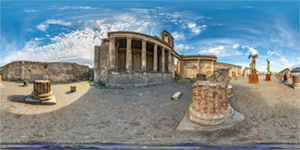
Pompeii's Basilica
Fullscreen
|
|
Pompeii's Sabatian Baths
The main entrance on via dell'Abbondanza leads to a large courtyard. The pool is found to the left, whereas a colonnade is found to the right, which leads to the men's quarters, which are split into the dressing room, with the for cold baths, which leads to the section for medium temperature baths and then to the section for hot baths. The heating was guaranteed by a piping system in the walls and double floors that circulated the hot air coming from the furnaces and from mobile braziers. The women's quarters, close to the men's quarters, was split the same way in the apodyterium, tepidarium and calidarium.
2017-03-13
Show on map
|
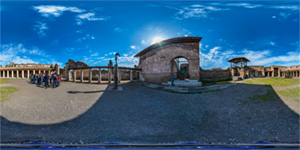
Pompeii's Sabatian Baths
Fullscreen
|
|
Pompeii's Gladitors Barracks
Behind the scene of the Large Theatre there is a large quadrangle surrounded by 74 Doric grey tuff columns of Nocera used as a foyer, an area where the spectators could stop during the intervals of the theatre shows. After the earthquake of 62 AD the building changed its function and became a barracks for gladiators, which resulted in certain parts of the building being reorganised. The most important rooms were those on the eastern side whereas the rooms upstairs may have been the apartments of the undertaker of the gladiators.
2017-03-13
Show on map
|
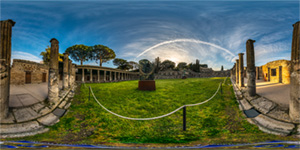
Pompeii's Gladitors Barracks
Fullscreen
|
|
Pompeii's Amphitheatre (Arena)
This amphitheatre is the oldest among those known from the Roman times. Built in 70 BC. It could hold up to 20,000 spectators not only from Pompeii but also from neighbouring towns. The building is located in a peripheral area so as to facilitate the movement of so many people. External staircases with two flights provide access to the upper steps and a downward corridor provides access to the lower steps. The arena is separated from the area intended for the spectators by a parapet which is decorated with frescos of gladiators. Roman Empire.
2017-03-13
Show on map
|
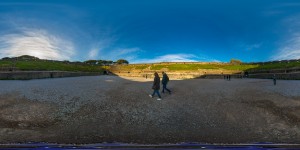
Pompeii's Amphitheatre (Arena)
Fullscreen
|
|
Pompeii's Mercuri Street
Street in Pompeii, Rmoan Empire (Italy).
2017-03-13
Show on map
|
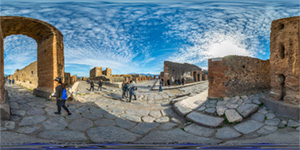
Pompeii's Mercuri Street
Fullscreen
|
|
Pompeii's Abbondanza Street
Street in Pompeii, Roman Empire (Italy).
2017-03-13
Show on map
|

Pompeii's Abbondanza Street
Fullscreen
|
|
Pompeii's Abbondanza Street (2)
Street in Pompeii.
2017-03-13
Show on map
|
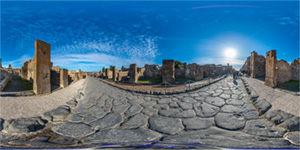
Pompeii's Abbondanza Street (2)
Fullscreen
|











